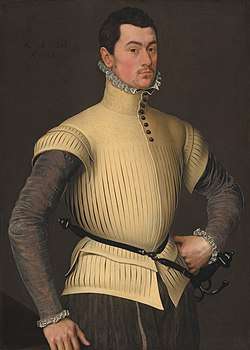Willem IV van den Bergh
Willem IV, Count van den Bergh (24 December 1537 in 's-Heerenberg, Gelderland – 6 November 1586 in Ulft) was Stadtholder of Guelders and Zutphen from 1581 until his arrest for suspected treason in 1583.

Biography

Willem was the son of count Oswald II van den Bergh[1] and Elisabeth van Dorth. He spent time at the court of the Regent Mary of Austria (1505–1558) of the Habsburg Netherlands in Brussels at the same time that his contemporary William the Silent, Prince of Orange was educated there. He married the elder sister of Orange, Maria of Nassau, on November 11, 1556 at Moers.
In 1566 he was a prominent member of the League of Nobles (also known as the Compromis) that presented a petition of grievances about the suppression of heresy to the Brussels government of the new Regent Margaret of Parma (who acted for her brother Philip II of Spain). They were derided as Geuzen ("Beggars") for their trouble by a courtier, which epithet would become a name of honor for the future rebels in the Dutch Revolt. This prominence put him in the crosshairs when Fernando Álvarez de Toledo, 3rd Duke of Alba succeeded Margaret as governor-general of the Netherlands in 1567 and started a program of repression. Together with a number of other "ringleaders", like Orange, Willem was indicted before the Council of Troubles, but he escaped with his family to Bremen.
In 1572 he commanded one of the little armies of mercenaries, financed by his brother-in-law the Prince of Orange, that invaded the Netherlands. He was successful initially, and conquered in short order Doetinchem, Zutphen, Deventer, Zwolle, Kampen, and Steenwijk. However, he was not able to withstand the onslaught of the Spanish troops under Alba's son Fadrique Álvarez de Toledo, 4th Duke of Alba. Only after the Pacification of Ghent, of whose amnesty he benefited, was he able to return to the Netherlands and regained his forfeited possessions.
Though he hoped to be appointed stadtholder of Gelderland on behalf of the States-General of the Netherlands, this ambition was initially thwarted when his other brother-in-law got the post. Disaffected by this disappointment he secretly approached the new royal governor-general of the Netherlands, Alexander Farnese, Duke of Parma with the object of becoming the royal stadtholder of Guelders and Zutphen (which county at the time was still separate from the current province).
However, John resigned the office in 1581 and now Willem was appointed stadtholder for the rebellious States-General after all. He remained in contact with Parma nevertheless, and stealthily sabotaged the military efforts of the Rebels, which may have contributed to the Spanish successes in the eastern provinces of the Netherlands in these years. His treasonous correspondence was discovered and he was arrested by the chancellor of Guelders, Elbertus Leoninus on November 5, 1583.[2] Soon thereafter he was released after he promised to retire to his castle in Ulft and remain neutral in the conflict.[3]
After his release, however, he defected to the royalist forces after all, together with his sons. Four of his sons with his wife Maria of Nassau became officers in the Spanish service, and performed important services for the Spanish cause :
- Count Herman van den Bergh (1558–1611),
- Count Frederik (1559–1618),
- Count Oswald III (1561-1586),
- Count Hendrik van den Berg (1573–1638) he ended up defecting from the Spanish to the States side.
References
- The name "Van den Bergh" is a surname ("De Monte"); the name "Bergh" refers to the lordship Bergh.
- Blok, P.J., (Translated by O.A.Bierstadt, R. Putnam) (1900) History of the people of the Netherlands. Part III The War wit Spain, p. 170
- Newsletter Oranje-Nassau.org (Dutch)
Sources
- (in Dutch) Aa, A.J. van der, et al. (1869), "Willem van den Bergh" in: Biographisch Woordenboek der Nederlanden II, eerste stuk, (Haarlem) pp. 386–390